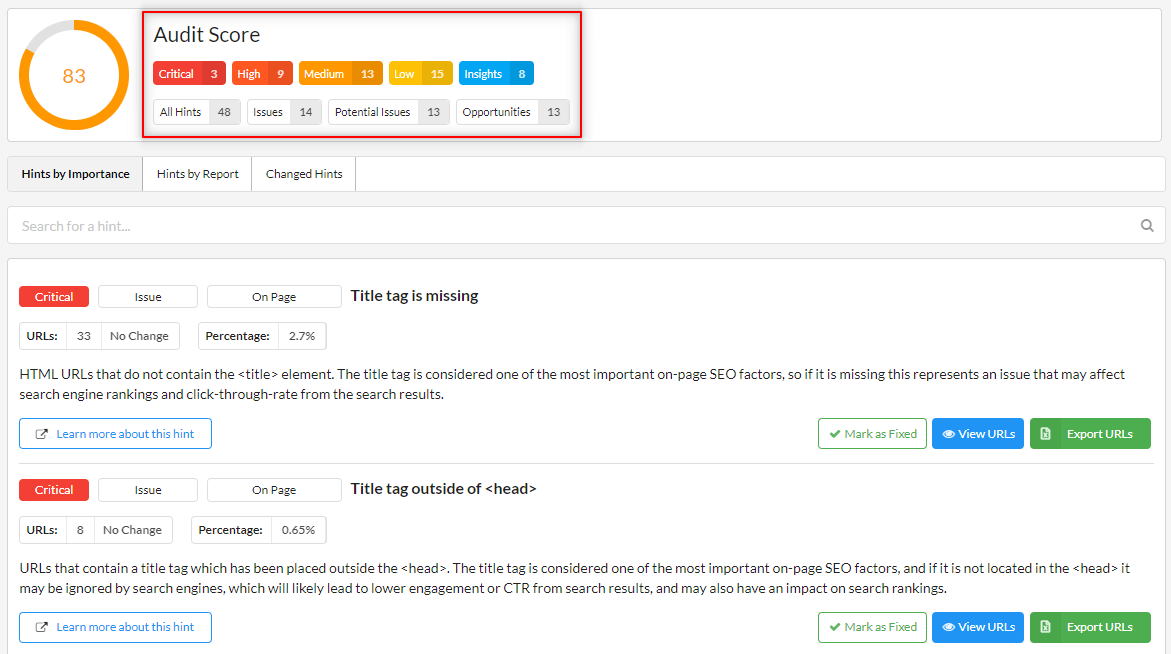
How To Deal With Expired Articles That Are No Longer Relevant
Published June 11, 2024
Thank you to Nafisah Mayun for this week’s contribution, which dives into the what, why and how of dealing with “expired” articles.
Just like that forgotten carton of milk, expired content can sour your website's reputation and drive visitors away.
Outdated content hurts your search engine ranking and credibility. Search engines favour fresh, relevant information, while visitors see old content or inaccuracies as unprofessional. Let's blow away those cobwebs and transform your website into a haven of valuable, current content!
In this piece, you will learn how to deal with expired articles as we delve into practical strategies to rejuvenate your outdated content, maintain your website's freshness, and ensure your readers stay hooked.
Table of contents:
- What is an expired article?
- How to recognize expired articles
- Importance of addressing expired articles
- How to identify expired articles
- Strategies for dealing with expired articles
- Communicating changes to users and search engines
What is an expired article?
An expired article is a piece of content that has lost its current relevance for your audience. This may be because of outdated facts, new trends, or obsolete strategies. I like to think of expired content as that outdated gadget gathering dust in the back of my closet – once useful and cutting-edge, now relegated to history.
These articles may have once held sway over search engine rankings, attracted droves of readers, and sparked lively discussions. Yet, as information evolves and trends shift, their relevance dwindles, leaving them languishing in the forgotten corners of your site.
Whether you're a seasoned content creator or a budding blogger, many of us face the dilemma of how to deal with expired articles.
How to recognize expired or outdated articles
Article expiration can manifest in various ways, depending on the content and external factors. Here are some common scenarios:
Content inaccuracy and dated information
The common cause of article expiration is outdated information. As time goes on, new developments and findings render previously accurate content irrelevant or incorrect. Articles that once provided valuable insights may become obsolete, especially in fast-changing fields like technology, law, or science.
Obsolete references
If your article contains references to products, technologies, terminologies or trends that newer alternatives have superseded, it's likely time for an update. If I’m reading a tech-related article and it mentions something about 'dial-up internet' or 'floppy disks', it’s most definitely outdated! Readers are less likely to engage with content that feels out of touch with current developments.
Declining engagement
A decline in engagement metrics, such as page views, time on page, and social shares, can indicate that your article is no longer resonating with your audience. Take note of these signals and consider whether the content needs to be refreshed or archived.
Broken links
Articles often link to external sources, such as studies, reports, or websites, to support their arguments or provide additional context. But, over time, these external sources may change or disappear, resulting in broken links within the article.
Broken links not only diminish the credibility of the article but also create poor user experience. This scenario can initiate the expiration of the article because the content can no longer provide a comprehensive and seamless experience to its users.
Tip: You can use Sitebulb’s website link crawler to find and fix broken links. Running a Sitebulb audit will give your website a Links Score based on key metrics such as followed, broken or redirected links. You’ll also get Sitebulb’s trademark Hints for link-related issues that need to be fixed.

Drop in search engine rankings
If your article has dropped significantly in search engine rankings or is no longer driving organic traffic, it may be a sign that it has become irrelevant or outdated.
Search engines prioritize delivering the most relevant and current results to users. So when an article's content becomes outdated, search ranking can drop. Over time it may even disappear completely.

Importance of addressing expired articles
Dealing with expired articles can be a real challenge. You may have poured your heart and soul into crafting the perfect piece, only to watch it gradually fade into obscurity as newer, shinier competitor content takes its place.
Here are 3 reasons why it’s worth addressing expired content:
1. SEO impact
Back in August 2018, John Mueller tweeted: “As a user, recognizing that old content is just being relabeled as new completely kills any authority that I thought the author / site had. Good content is not lazy content. SEO hacks don't make a site great. Give your content and users the respect they deserve.”

If your site contains numerous expired articles, it may signal to search engines and your users that your content is not up-to-date or authoritative, leading to lower rankings.
Updating expired articles ensures content freshness and tells Google and users that your content is new and relevant.
Google prioritizes delivering the most current and up-to-date information to users.
This focus on content "freshness" has continued to develop through major algorithm updates, such as:
2. User experience issues
Keeping your content fresh and up-to-date builds trust among your audience. Outdated articles may contain incorrect information or references to events that have already occurred, leading users to question your site's credibility. This can damage user trust and result in a higher bounce rate as visitors navigate away from your site in search of more reliable sources.
However, when users trust your content, they're more likely to link to, share, or engage with it, expanding your online presence and generating more traffic to your site.
3. Wasted resources
Creating and maintaining content requires time, effort, and often financial resources. Allowing expired articles to remain on your website consumes your crawl budget without providing any tangible benefits. Fresh content competes for attention with expired ones delaying fresh content indexation.
Here’s what Google’s John Mueller had to say:
“What would happen is we would just index all of these old pages and we’d have trouble focusing on the important stuff on your website.”
When you update expired articles, you allocate resources more efficiently and focus on creating high-quality, valuable content that resonates with your audience.
How to identify expired articles
Some may think crafting fresh blog entries is the main activity of maintaining a blog. But, it's equally important to monitor your current content to see if it continues to serve your audience.
Every website that contains significant amounts of written content eventually grapples with outdated or expired content. Here are some ways to identify it:
Manual review
Periodic content assessment: Schedule regular manual reviews of your website's content inventory. This involves systematically going through each article to evaluate its relevance, accuracy, and timeliness.
Assess the quality of each article, looking for signs of outdated information, broken links, or references to obsolete events or products. Pay attention to user comments, inquiries, or complaints regarding specific articles. Users may alert you to inaccuracies or outdated information that needs attention.
Website audits
Schedule audits: Conduct comprehensive website audits regularly to identify articles that may have expired. This involves reviewing metadata, publication dates, and content relevance across your website.

All Sitebulb Hints provide you with descriptions, links to detailed information and the option to export or view the URLs affected.
Head back to your crawl and click on Sitebulb’s On-Page SEO Analysis report, to see key required data.

Categorization and tagging: Organize your content into categories or tags based on topics, themes, or publication dates. This makes it easier to identify and prioritize articles that require updating or removal.
Use analytics tools
Traffic and engagement metrics: Use web analytics tools like Google Analytics or Sitebulb’s website search traffic report to track traffic and engagement metrics for individual articles. Look for patterns of declining traffic, low engagement, or high bounce rates, which may indicate that an article has expired.
Conversion rates: Analyze conversion rates for articles that are intended to drive specific actions, such as sign-ups, downloads, or purchases. Pages with declining conversion rates may need updating to maintain their effectiveness.
Tips from experts for dealing with expired articles
You’ve figured out you have expired content, YAY! What’s the next step? Let’s explore effective strategies for managing expired articles to ensure that your website continues to provide valuable and engaging content.
Comprehensive content review
This involves systematically evaluating all articles on your website to identify those that have expired or are no longer serving their intended purpose. That’s what will drive your decision to update, redirect, or remove particular content.
Content strategist Melissa Popp had this to say:

You might ask, how often should I do this? I hate to say this but “it depends” (!) – on your business goals, target audience, website and resources. But I recommend that you set up a content review routine, possibly quarterly or yearly at most.
SEO Consultant Lauren Galvez offered me this advice:

Update expired content with current information, statistics, and examples. Verify facts and figures, replace outdated references, and ensure that the content reflects the latest developments in your industry or niche.
Let's say your article discussed social media marketing and heavily referenced features specific to Facebook's layout in 2015. Today, the platform's interface and functionalities have changed significantly. Updating the content with current information and examples relevant to today's Facebook layout would be crucial. Or take Universal Google Analytics, for instance. If you previously mentioned it in your article, you'll want to update the information to reflect the emergence of the newer, more advanced GA4 version.
Ivan Ivic, a content marketing expert, suggests focusing on search intent, content framework, and identifying gaps in the existing content when updating outdated articles. This approach ensures you create a comprehensive and valuable piece that surpasses what's already ranking in search results.

Redirect expired URLs
Redirect expired URLs using 301 redirects to automatically direct users and search engines to relevant pages. This preserves link equity, prevents 404 errors and ensures a seamless browsing experience for visitors.
Choose redirect pages carefully, and ensure you’re directing users to closely related content or providing a suitable alternative to the expired page. Also, be sure that the page you’re directing users to won’t expire soon, or you may have a redirect chain on your hands.
Consider relevance, user intent, and SEO implications when selecting redirect targets. DON’T just redirect to the homepage.

Remove or archive expired content
Deleting outdated content will enhance your site’s overall quality, provided the URL in question no longer offers any value at all.
Here’s what SEO expert Preeti Gupta, founder of Packted had to say:

Evaluate the impact of removing or archiving content on SEO, user experience, and website structure. Consider factors such as inbound links, user engagement, and historical significance when making removal decisions. And if you have seasonal content that you update for a yearly event, add the newest content to a reusable URL as per John Mueller’s recommendation:
“If you have content that you update for a yearly event, for example, include the newest content on one re-usable URL where accumulative signals gained will allow it to rank higher, and move outdated content onto archive URLs.”

Properly handle content you’re removing to avoid broken links or 404 errors as this is an important aspect of maintaining a well-functioning website. Although, despite all precautions, some 404s may slip by. In this case, it's best to have a custom 404 page ready. This page should include links to your homepage, sitemap, search function, popular content, or any other main page to keep the user engaged.
Communicating changes to users and search engines
When dealing with expired articles, effective communication is essential to ensure that both users and search engines are aware of the changes. Here's how you can effectively communicate changes:
Strategic internal linking
When managing expired articles, start by reviewing your website's internal link structure to find any links pointing to outdated content. Update these internal links to align with current content, ensuring accuracy in both anchor text and URLs.
Linking strategically to your refreshed content from high-performing, relevant pages on your website helps distribute link equity and improve the overall ranking potential.
Also, maintain consistency throughout your website by updating links across related articles, navigation menus, and other site elements, to avoid confusion among users and search engines.
Notify search engines of content changes through sitemaps
Submit updated XML sitemaps to reflect changes in content. Use indexing tools, such as Google Search Console, to request reindexing of updated or redirected pages, so the latest content versions can be crawled and indexed.
Don’t forget to monitor the indexing status of updated or redirected pages to ensure search engines promptly recognize and reflect the changes in their search results.
How to prevent future articles from expiring
To avoid dealing with expired articles in the future implement proactive strategies that focus on creating sustainable, evergreen content.
Create evergreen content
One of the most effective ways to prevent articles from expiring is to create evergreen content. Evergreen content goes out of date much less quickly, remaining relevant to your audience regardless of when it's published.
Focus on topics that address fundamental questions, provide practical solutions, or offer timeless insights within your niche. This way, you can build a strong foundation of valuable resources that continue to attract and engage your audience over time.
Audit and refresh your content frequently
I can’t stress this enough! Regularly monitor and update your content to ensure its ongoing relevance and accuracy. As much as we all want to create evergreen content, that can’t always be the case.
Keep an eye on industry trends, audience feedback, and changes in search algorithms to identify opportunities for updates or improvements.
So to conclude, expired articles can spell trouble for both your search performance and credibility. Search engines prioritize current and relevant information, while visitors perceive inaccuracies as a lack of authority. Don't let expired articles drag down your website's reputation. Use website audit and analysis tools to identify opportunities for improvement and keep your content up-to-date.
You might also like:

Sitebulb is a proud partner of Women in Tech SEO! This author is part of the WTS community. Discover all our Women in Tech SEO articles.

Nafisah Mayun is a junior technical SEO specialist with over two years of content writing experience. Discovering a passion for SEO in 2023, she focuses on enhancing businesses' visibility on SERPs. Currently delving deeper into the 'search world', she is committed to further improving her technical SEO skills.
Articles for every stage in your SEO journey. Jump on board.
Related Articles
 How to Stay Relevant in a World of AI Overviews & Query-Fans
How to Stay Relevant in a World of AI Overviews & Query-Fans
 Content Refresh Guide: How to Improve Your Search & AI Visibility
Content Refresh Guide: How to Improve Your Search & AI Visibility
 How to Optimise Agent Relationships & Content for Better Real Estate Marketplace SEO
How to Optimise Agent Relationships & Content for Better Real Estate Marketplace SEO
 Sitebulb Desktop
Sitebulb Desktop
Find, fix and communicate technical issues with easy visuals, in-depth insights, & prioritized recommendations across 300+ SEO issues.
- Ideal for SEO professionals, consultants & marketing agencies.
Try our fully featured 14 day trial. No credit card required.
Try Sitebulb for free Sitebulb Cloud
Sitebulb Cloud
Get all the capability of Sitebulb Desktop, accessible via your web browser. Crawl at scale without project, crawl credit, or machine limits.
- Perfect for collaboration, remote teams & extreme scale.
If you’re using another cloud crawler, you will definitely save money with Sitebulb.
Explore Sitebulb Cloud Nafisah Mayun
Nafisah Mayun


